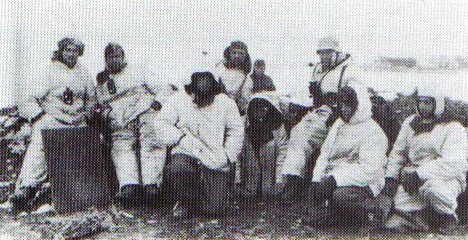On the same day as 8.LwFD marched into the trap near Nizhne Chirskaya, 2.LwFD was crushed by a massive Soviet offensive of six armies against the German Ninth Army in the Rzhev salient. Once again, heavy snows combined with strong frontal attacks and partisan raids crippled the novice 2.LwFD at the town of Belyi. The Germans quickly rallied with reinforcements of veteran units, including Panzer Grenadier Division ‘Grossdeutschland’, and the threat to Army Group Centre diminished by mid-December. Much of the blame for the initial debacle at Belyi was placed on 2.LwFD, which, no doubt, was totally unsuited for its new role. The division was soon removed from the salient and transferred to II.LwFK at Vitebsk.
#
The 2nd Luftwaffe Division is defending the line west of a major road from a point 5km southwest of Belyi thru a series of towns on that major road in that direction for 8km to Demakhi and again southwest for some distance,10km, through swampy forest west of that road.
General Solomatin, the 1st Mechanized Corps commander, had selected his second variant for committing his corps into battle, and he would lead the attack with his two tank brigades and a mechanized brigade. The artillery was registered in, sappers were doing their dangerous work in the fields and low broad valley to their front, and hours before, reconnaissance parties had felt out German defenses all along the entire army front. In the darkness before them, light snow fell, which softened the stark outlines of surrounding trenches, grotesquely broken trees, and the icy rims of nearby shell holes. Tarasov was satisfied. Everything had gone according to plan, and now it would be up to his massed troopers to traverse the open terrain to the road and beyond into the wood lines that masked the main German defense line. Once across this killing zone, Solomatin’s armor could wreak its havoc. Tarasov knew that almost half of his chosen penetration sector was manned by air force troops of the German 2d Luftwaffe Field Division, ersatz troops that represented Air Marshal Hermann Goering’s donation to the German ground war effort. Tarasov and his staff derisively referred to these half-trained troops as “Army Group Center’s Rumanians.” He hoped they would oblige by collapsing like the real Rumanians had a week before along the Don, but privately he was not so sure they would.
Despite the general expectations of a Russian assault, the ferocity, strength, violence, and location of the blow surprised the German XXXXI Panzer Corps headquarters. Colonel General Joseph Harpe, the corps commander, listened intently to his chief of staff as he outlined the carnage of the day. It was clear that the Russians had torn a gaping hole in German defenses between Belyi and Demekhi, and the severity of the blow had smashed the better part of two regiments of the Luftwaffe division and a regiment of the 246th Infantry Division. Thankfully, thought Harpe, the energy of the Russian thrust is apparently straight ahead and not directed at Belyi proper. Remnants of the 246th Infantry Division’s 352d Grenadier Regiment clung grimly to the forward German trench lines south of Belyi, and the vaunted air force troopers, or what was left of them, still clung to Demekhi, but only barely.
However, what was done was done. The important thing now was to shore up the defenses along the shoulders of the Russian penetration, prevent the fall of Belyi, and stop the Russians short of the Nacha River. Harpe knew that Belyi had been in German hands since late 1941, and in addition to having considerable symbolic value, it was a critical node in the Rzhev salient defenses in general. The Russians could get at the city in two ways: either by direct assault, or by cutting its rearward communications routes, which lay along and west of the Nacha River valley. These two realities dictated all of Harpe’s subsequent actions.
At midday, before the full picture of the situation had emerged, Harpe traveled to 1st Panzer Division, where he met with the division commander, Lieutenant General Walter Kruger, and with Ninth Army commander, General Model, who had flown in for the meeting in his Fieseler Storch aircraft. Model, concerned with the major attack along the Vazuza River, also well understood the importance of “Fortress Belyi” and the 1st Panzer Division’s potentially vital role in its defense. Together, the three generals reviewed their options, giving priority to bolstering the Belyi defense, slowing the Russian advance, and erecting blocking positions along the Nacha River. The 1st Panzer would play a key role in all three tasks.
The shaken remnants of the 352d Grenadier Regiment clung desperately to defenses around the little hamlet of Budino in the Vishenka valley, which was just northeast of the ruined defenses at Klemiatino. There, a battalion of the 352d stubbornly held out against overwhelming force. The 246th Infantry Division had dispatched all the reserves it could muster to reinforce the battalion, but few were available since the entire front around Belyi was under Russian assault. In addition, late on the first day of battle, the neighboring 86th Infantry Division to the north dispatched its 2d Battalion, 167th Grenadier Regiment, to reinforce the 352d Regiment’s defense.
